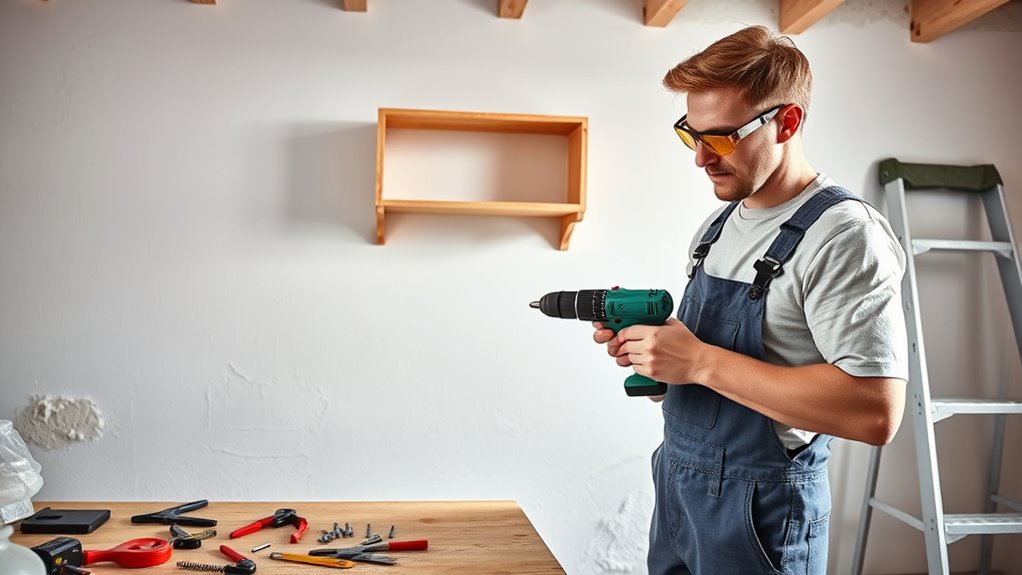Starting DIY home repairs is a smart move to save on maintenance costs and build your skills. Begin with small projects like fixing leaks or patching walls, using the right tools and safety gear. Plan carefully, shop smart, and focus on essential supplies to avoid unnecessary expenses. Practice patience and attention to detail, recognizing when to call professionals. Keep learning practical tips to tackle projects confidently—more guidance awaits to help you succeed.
Key Takeaways
- Start with small, manageable projects to build confidence and skills gradually.
- Use the right tools and follow safety guidelines to prevent accidents and ensure quality repairs.
- Plan and budget carefully, researching affordable supplies and focusing on essential tools.
- Learn proper techniques through online tutorials and practice to improve repair efficiency.
- Recognize when professional help is needed to avoid costly mistakes and ensure safety.

Ever wondered if you can tackle home repairs yourself? The good news is, with some basic knowledge and a cautious approach, you absolutely can. Starting with DIY repairs not only saves you money but also boosts your confidence around your home. However, before diving in, it’s critical to prioritize tool safety. Using the right tools correctly prevents injuries and ensures your work is effective. Always read the instructions, wear protective gear like gloves and goggles, and keep your workspace organized. Handling tools properly is the foundation of safe DIY projects. Additionally, thoughtful budget planning helps you avoid overspending on supplies or equipment. Before heading to the store, list out what you need and research affordable options online. This way, you can avoid impulse buys and stick to your financial limits. When you’re planning your repairs, consider whether a task is manageable on your own or if it’s better to consult a professional. Small projects like fixing a leaky faucet or patching a hole in the wall are perfect starting points. For these tasks, investing in basic tools such as a screwdriver set, a utility knife, and a putty knife will serve you well. When shopping for tools and materials, compare prices, look for quality brands, and buy only what’s necessary for the job. It’s tempting to get every gadget on the shelf, but focusing on essentials will save money and storage space. Remember, good tool safety practices extend to using the right tools for each task—don’t force a tool to do something it’s not designed for. Doing so can damage the tool and increase the risk of injury. As you gain experience, you’ll learn to assess your skills realistically and know when to call in a professional. Starting small helps you build confidence and learn proper techniques without feeling overwhelmed. You’ll also develop a better understanding of how to plan your projects, allocate your budget, and gather the right tools. Over time, these skills will make future repairs easier and more cost-effective. Keep in mind, patience and attention to detail are key. Rushing through repairs can lead to mistakes, which may end up costing you more in the long run. Additionally, understanding your vibrational energy can help you stay motivated and positive throughout your DIY journey. By carefully planning your repairs, practicing tool safety, and staying within your budget, you set yourself up for success. DIY home repairs become less intimidating when you approach them with the right mindset and preparation. With each project, you’ll gain new skills and confidence, turning home maintenance from a chore into a rewarding hands-on experience.
Frequently Asked Questions
What Tools Are Essential for Basic Home Repairs?
You need a hammer, screwdrivers, pliers, a tape measure, and a wrench for basic home repairs. These tools help you handle tasks safely and efficiently, so always prioritize home repair safety. Keep your tools in good condition through regular tool maintenance to guarantee they work properly and last longer. With these essentials, you can tackle many small repairs around your home confidently and cost-effectively.
How Do I Identify a Plumbing Leak?
Think of plumbing leaks as sneaky predators hiding in plain sight. To identify them, perform a plumbing inspection by checking for water stains, mold, or dampness around pipes and fixtures. Use leak detection methods like listening for hissing sounds, feeling for drips, or inspecting your water meter for unexplained movement. Catching leaks early saves water and money—so stay vigilant and trust your senses!
Is Electrical Wiring Safe for DIY Repairs?
Electrical wiring can be safe for DIY repairs if you follow proper electrical safety and understand wiring basics. Always turn off the power at the circuit breaker before working on any wiring, and use insulated tools. If you’re unsure about wiring connections or local codes, it’s best to consult a professional. Prioritize safety to avoid shocks, fires, or code violations, and never work on live circuits.
How Can I Prevent Future Repair Issues?
It’s no coincidence that staying ahead of repairs often begins with regular preventative maintenance and consistent inspection routines. You can prevent future issues by scheduling seasonal checks, cleaning critical components, and promptly addressing minor problems before they escalate. Keep a maintenance log, and don’t ignore odd signs; they’re often clues that something needs attention. By staying proactive, you’ll extend the life of your home systems and save money in the long run.
When Should I Call a Professional Instead of DIY?
You should call a professional when a repair involves complex tasks, significant safety precautions, or uncertain cost estimation. If you lack the necessary skills or tools, it’s safer and more cost-effective to seek expert help. Attempting repairs beyond your experience can lead to bigger issues or hazards. Trust your judgment—if something feels risky or complicated, don’t hesitate to contact a professional to ensure safety and proper repair.
Conclusion
Taking on DIY home repairs not only boosts your confidence but can also save you up to 23% on maintenance costs annually. With just a few basic tools and some guidance, you can handle many common issues around your home. Remember, starting small builds your skills and confidence over time. So, don’t be afraid to roll up your sleeves—your wallet will thank you, and you’ll gain a valuable new skill set in the process.









